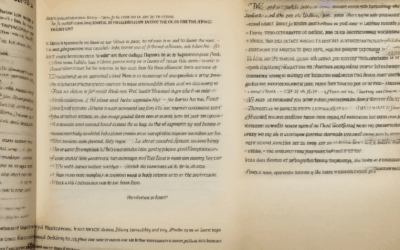Understanding and articulating your purpose is a cornerstone of self-discovery and effective communication, whether you’re crafting a personal manifesto, a professional statement, or an academic thesis. In today’s dynamic world, having a clear sense of purpose serves as a guiding light, helping individuals and organizations connect with their goals and inspire others. This comprehensive guide delves into the art of writing about purpose, offering insights, examples, and practical strategies to help you craft a compelling narrative that resonates deeply with your audience. From personal reflections to professional alignments, we’ll explore the various facets of purpose, providing actionable tips and real-world examples to ensure your purpose statement stands out. By the end of this exploration, you’ll be equipped with the tools to articulate your unique purpose effectively, fostering meaningful connections and driving impactful change.
Key Takeaways
– Understand the core elements of a purpose statement to craft a clear and impactful document.
– Align your purpose with your goals, whether for academic or professional endeavors.
– Include personal background, experiences, and future aspirations to strengthen your narrative.
– Follow a structured approach when drafting your statement of purpose for better coherence.
– Balance authenticity with professionalism to convey confidence and dedication.

Example of Writing a Purpose
To investigate the impact of social media on teenagers’ mental health in urban schools, this study will conduct surveys and interviews with students aged 13-18 and compare the findings to national statistics.
- The purpose statement begins with a clear action verb (“investigate”) and specifies the subject matter (“impact of social media”).
- It outlines the methods to be used (“surveys and interviews”) and the population focus (“teenagers in urban schools”).
- The statement is concise yet comprehensive, setting clear expectations for the research.
Critique: This example effectively combines specificity with clarity, making it easy for readers to understand the focus of the study.
For more insights into crafting purposeful content, visit our blog at Peter Spirito and explore our collection of thought-provoking articles.
The Four Types of Purpose
The four primary purposes of writing or communication are often categorized to help clarify their intent and impact. Understanding these purposes can aid in crafting effective content that resonates with audiences.
- Entertain: This purpose focuses on providing enjoyment, relaxation, or amusement. Examples include stories, jokes, or humorous articles. Entertainment often aims to engage the audience in a lighthearted manner.
- Inform: This purpose seeks to educate, teach, or provide useful information. Content like tutorials, news articles, or instructional guides falls under this category. The goal is to transfer knowledge effectively.
- Persuade: This purpose involves influencing opinions, actions, or decisions. Persuasive writing can be found in advertisements, speeches, or editorials. The aim is to convince the reader to adopt a certain viewpoint or take action.
- Discuss: This purpose revolves around exploring ideas, debating concepts, or fostering dialogue. Content like forum discussions, academic papers, or collaborative projects fits here. The focus is on exchanging ideas and stimulating thought.

How Do You Write Your Purpose?
Your purpose is a unique expression of your beliefs, goals, and aspirations. It serves as your guiding principle, helping you navigate life’s challenges and opportunities. Writing your purpose can feel overwhelming, but breaking it down into key components can make the process easier.
Core Values
- Authenticity: Stay true to yourself and your values. Your purpose should reflect who you are and what you believe in.
- Growth: Embrace learning and evolution. Your purpose may change over time as you grow and gain new insights.
- Connection: Focus on relationships and community. Your purpose often involves contributing to the well-being of others.
Who Is Your Audience?
Your purpose is meant for more than just yourself. Consider who will benefit from your words, ideas, or actions. At Peter Spirito, we aim to inspire readers through authentic stories and creative reflection .
What Impact Should It Have?
Your purpose should leave a lasting impact. It should challenge, inspire, and guide others in their own journeys. Our blog seeks to connect with readers who are seeking inspiration and exploring life’s complexities.
Conclusion
Writing your purpose is a deeply personal journey. Take your time to reflect, explore, and articulate what truly matters to you. Share it with the world in a way that resonates with others, just as we strive to do at Peter Spirito.

What is an example of a purpose statement?
Peter Spirito’s blog serves as a platform for sharing authentic personal stories and reflective musings on life’s journey. Through heartfelt essays and creative insights, the blog aims to connect readers with meaningful content that fosters self-discovery and encourages readers to explore their own unique paths.
The Purpose
To inspire and engage readers with authentic storytelling and creative reflections that resonate deeply with their personal journeys.
The Mission
Providing a space for readers to explore life’s adventures, creativity, and self-discovery through thoughtfully crafted narratives and insightful musings.
The Values
- Authenticity
- Connection
- Growth
- Innovation
The Features
- Personalized essay collections
- Creative writing prompts
- Community discussions
- Resource library
Peter Spirito’s blog stands out by combining emotional storytelling with practical advice, making it a go-to resource for anyone seeking inspiration or looking to reflect on their own experiences. The platform also emphasizes building a supportive community where readers can share their own stories and connect with others who are on similar journeys.
A Good Example of a Statement of Purpose
Upon completing my undergraduate studies in Biology, I am eager to further my education and contribute to advancements in molecular genetics. My ultimate goal is to pursue a Ph.D. in Molecular Genetics to investigate the genetic mechanisms underlying complex traits, particularly focusing on neurodegenerative diseases. This pursuit aligns with my academic background and passion for understanding the fundamental aspects of life at the molecular level.
During my undergraduate years, I conducted independent research on gene expression regulation in model organisms, which deepened my appreciation for the intricate workings of cellular biology. My findings were published in a reputable scientific journal, demonstrating my capability to contribute meaningfully to the field. Additionally, I interned at a leading biotechnology company, where I applied genomics techniques to develop diagnostic tools, further honing my technical skills and research acumen.
I am particularly drawn to [University Name]’s Molecular Genetics program due to its world-renowned faculty and state-of-the-art facilities. I am excited to work under the guidance of Professor Jane Doe, whose innovative approaches to studying Alzheimer’s disease resonate deeply with my research interests. I am confident that her mentorship will greatly enhance my academic and professional development.
My long-term vision includes contributing to the development of therapeutic interventions for neurodegenerative disorders. By pursuing a Ph.D., I aim to bridge the gap between basic research and clinical applications, ultimately aiming to improve patient outcomes. I am committed to becoming an outstanding scientist who can effectively communicate complex concepts to diverse audiences, fostering public understanding of scientific advancements.
In conclusion, I am motivated by a profound curiosity for the molecular basis of life and a desire to make meaningful contributions to scientific knowledge. I am confident that [University Name]’s program will provide the ideal environment for me to achieve my academic and professional aspirations.

How to Begin Your Statement of Purpose
To craft an effective statement of purpose, start by introducing yourself and explaining your academic and professional background. Mention the specific program you’re applying to and why it aligns with your goals. Highlight relevant coursework, experiences, and skills that prepare you for the program. Conclude with your future aspirations and how the program will help you achieve them.
Example structure:
- Introduction : Briefly describe yourself, including your academic and professional background.
- Academic Background : Discuss relevant coursework and experiences.
- Professional Background : Highlight work experience, projects, or internships.
- Program Selection : Explain why you chose the specific program and university.
- Future Goals : Describe your long-term career plans and how the program will aid them.
For a more personalized touch, include links to your portfolio or LinkedIn profile to showcase your work and achievements.




0 Comments